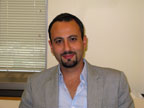|
CCMB Grantsmanship Lecture Series
|
CCMB Grantsmanship Lecture Series
|
|
Issam Zineh
Associate Director for Genomics
U.S. Food and Drug Administration
Shortening the Translational Lag on the Critical Path to Personalized Medicine
|
 |
Abstract:
Individualization of therapeutic interventions has been the goal of medicine since its inception. The completion of the Human Genome Project has catalyzed one of the most exponential growths in the history of biomedical innovation. To date, however, there have been few examples of successful translation of pharmacogenetic and genomic discoveries to the clinic. This talk will discuss the progress, challenges, and next steps in personalized medicine.
Watch the lecture: [high quality]
Tuesday, November 24th, 2009
5:30pm
SWIG Boardroom Room 241, CIT
A light dinner will be served at 5:15pm
|
CCMB Grantsmanship Lecture Series
|
|
Samuel Broder
Celera Corporation
The Development of Antiretroviral Therapy and Its Impact on the Global HIV-1/AIDS Pandemic: Lessons from “treating an untreatable” infectious agent.
|
 |
Abstract:
In the last twenty- five years, HIV-1, the pathogenic retrovirus responsible for Acquired Immunodeficiency Syndrome (AIDS), has gone from being an “inherently untreatable” infectious agent to one eminently susceptible to a range of approved therapies. During a five year period, starting in the mid-1980s, my group played a role in the discovery and development of the first generation of antiretroviral agents. We focused on zidovudine (AZT) and related congeners in the dideoxynucleoside family of nucleoside reverse transcriptase inhibitors (NRTIs), taking them from the laboratory to the clinic in response to the pandemic of AIDS, then a terrifying and lethal disease. These drugs proved, above all else, that HIV-1 is treatable, and such proof provided momentum for new therapies from many sources, directed at a range of viral targets, and at a pace that has been rarely if ever matched in modern drug development. Antiretroviral therapy, despite many prophecies of failure, has brought about a substantial decrease in the death rate due to HIV-1 infection. In resource-rich nations, such therapy has changed the nature of HIV-1 infection from a rapidly lethal disease into a chronic manageable condition, one compatible with very long survival. Most of the available therapies are oral medicines, administered on relatively convenient schedules. Several have been specially formulated as fixed-dose, generic-drug combinations for even greater utility in resource-poor nations. This has special implications within the classic boundaries of public health around the world, but at the same time in certain regions may also affect a cycle of economic and civil instability in which HIV-1/AIDS is both cause and consequence. Many challenges remain, including 1.) life-long duration of therapy; 2.) the ultimate role of pre-exposure prophylaxis (PrEP); 3.) cardiometabolic side effects or other toxicities of long-term therapy; 4.) the emergence of drug-resistance and viral genetic diversity (non-B subtypes); 5.) the specter of new cross-species transmissions from established retroviral reservoirs in apes and Old World monkeys; 6.) the continued pace of new HIV-1 infections in many parts of the world; and 7.) barriers or inefficiencies in providing state-of-the-art medical care. All of these factors make refining current therapies and developing new therapeutic paradigms essential priorities. Nonetheless, there is a short journey from basic research to public health benefit around the world. The current science will likely lead to new strategies of therapy against HIV-1 with far-reaching implications in the HIV-1/AIDS pandemic. Perhaps there are broader lessons for a wholeness of motion from lab bench to the clinic and back again, with potential relevance to a range of other “untreatable” conditions.
Tuesday, November 3rd, 2009
5:30pm
SWIG Boardroom Room 241, CIT
Watch the lecture: [high quality]
Watch the CSCI2950-L Medical Bioinformatics lecture entitled "The Human Genome: Sequencing and Assembling 3 Billion Letters of Code Was the Easy Part": [high quality]
|
CCMB Grantsmanship Lecture Series
|
|
Jonathan Yewdell
Chief of the Cellular Biology Section, Laboratory of Viral Diseases
National Institute of Allergy and Infectious Diseases, NIH
How to Succeed in Science
|
 |
Abstract:
Biomedical research has never been more intellectually exciting or practically important to society. Ironically, pursuing a career as a biomedical scientist has never been more difficult. I will provide unvarnished advice to nascent biomedical scientists on the difficulties that lie ahead, and on how to find the right laboratories for training in the skills required for success. Once you have found a laboratory, making discoveries will be your most important objective, and also the most enjoyable aspect of your new career. You need to develop the experimental and mental skill sets that enable you to make discoveries, including how to recognize and exploit serendipity when it strikes. I will provide practical advice on choosing a research topic, designing, performing and interpreting experiments and, last but not least, on maintaining a semblance of your sanity in the process.
Tuesday, October 13th, 2009
5:30pm
SWIG Boardroom Room 241, CIT
Watch the lecture: [low quality] [high quality]
_______________________________________________________ Events
|



